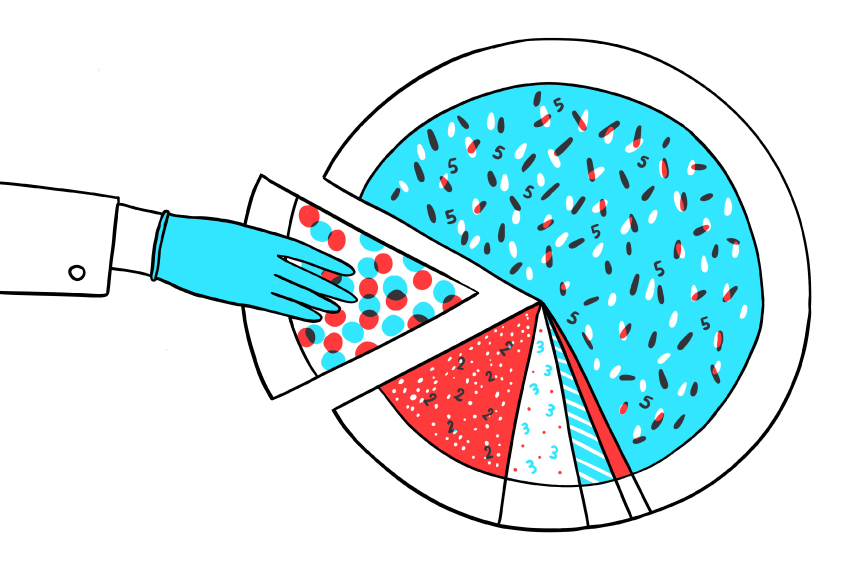Welcome to this month’s edition of By the Numbers. At Spectrum, we do our best to summarize the latest autism research findings. Sometimes, the best summary comes in the form of a chart or map. In this newsletter, we boil down new research that is conveyed most succinctly with data visualizations.
Let us know what you think of the newsletter, or tell us about your own work, at [email protected].
Autism screening results vary widely between languages
Researchers often translate the Modified Checklist for Autism in Toddlers, Revised (M-CHAT-R) in a ‘forward-back’ fashion, converting an English form of the tool word for word into another language without accounting for cultural context.
Such literal translations, it turns out, can lead to vastly inflated screen-positive rates, according to a new study, published new in the Journal of Developmental and Behavioral Pediatrics. The researchers assessed medical charts from 2,974 toddlers, aged 16 to 30 months, whose caregivers had completed an English or Spanish Western-Hemisphere version of the M-CHAT-R.
The latter screening tool was associated with significantly higher overall scores and higher initial screen-positive rates for autism. Caregivers who used the Spanish version were also more likely than caregivers who used the English version to leave items blank.
Other forward-back translations present similar issues: A Turkish version of M-CHAT-R, for instance, led to a screen-positive rate of nearly 50 percent in one 2012 study.
U.S. autism prevalence inches upward as racial gaps close
Autism prevalence in the United States rose to 1 in 44 children in 2018, up from 1 in 54 in 2016, according to a new analysis of 8-year-olds in 11 states. The data are based on health and education records for 220,281 children, collected as part of the U.S. Centers for Disease and Control and Prevention’s (CDC) Autism and Developmental Disabilities Monitoring Network.
“It certainly seems like some of this change is due to the way children are being identified, diagnosed and served in their communities,” says Matthew Maenner, an epidemiologist and surveillance team lead for the CDC’s National Center on Birth Defects and Developmental Disabilities.
Prevalence was lowest among white children, compared with Black, Hispanic, Asian and Pacific Islander children.
The findings appeared in the Morbidity and Mortality Weekly Report in December.
Autism without intellectual impairments more common than previously reported
More than half of autistic people in the United States have an average or above-average intelligence quotient, an uptick over previous estimates, a new longitudinal study of children in Minnesota suggests.
In 2016, the proportion of autistic children in the U.S. with an average or higher intelligence quotient was 42 percent, according to CDC autism prevalence data published in 2020. The new study, however, suggests that this number could be as high as 59 percent. The finding is based on healthcare records from 890 people who met the inclusive definition of autism, according to the fourth edition of the Diagnostic and Statistical Manual of Mental Disorders.
The study appeared in November in Pediatrics.
Spectrum index:
15.8: The proportion of parents who say their autistic child is moderately depressed, according to a study that surveyed 101 children and their parents. By contrast, nearly 28 percent of children surveyed said that they were moderately depressed. The results were published in BMC Psychiatry in November.
342: The percentage by which autism prevalence has increased in Wales between 2001 and 2016, according to a study published in November in Autism that drew on healthcare records from more than 3.6 million people. The study put the overall prevalence of autism in Wales at 0.51 percent.
43: The percentage of people with fragile X syndrome, out of 975 surveyed, who take a selective serotonin reuptake inhibitor, a class of drugs designed to treat depression, according to a study that appeared in the Journal of Child and Adolescent Psychopharmacology in November. More than 63 percent of the participants were taking a psychotropic medication or investigational drug, and the rates of medication use were highest among men and adolescents.
30: The percentage of 706 children and young adults with fragile X syndrome who snore loudly while sleeping, according to a study published in the American Journal of Medical Genetics - Part A in December. Only about 15 percent of children without fragile X snore regularly, according a 2004 study.






